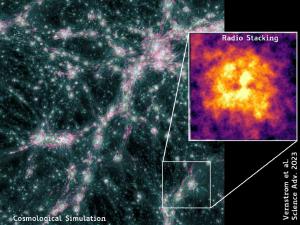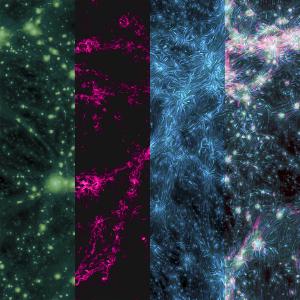Blog
The Magnetic Web
26 February 2023
 Vernstrom et al
Vernstrom et alThe universe is filled with magnetic fields. Although the universe is electrically neutral, atoms can be ionized into positively charged nuclei and negatively charged electrons. When those charges are accelerated, they create magnetic fields. One of the most common sources of magnetic fields on large scales comes from the collisions between and within interstellar plasma. This is one of the major sources of magnetic fields for galactic-scale magnetic fields.
But magnetic fields should also exist on even larger scales. At the largest scale of the cosmos, the matter is distributed in a structure known as the cosmic web. Large superclusters of galaxies are separated by barren voids, like clusters of soapy water among a vast region of soap bubbles. Thin filaments of intergalactic material stretch between these superclusters, creating a cosmic web of matter. Much of this web is ionized, so it should create vast but faint intergalactic magnetic fields. At least that’s the theory. Astronomers haven’t been able to observe these web magnetic fields. But a new study has made the first detections of them.1
 K. Brown
K. BrownWe can’t directly detect magnetic fields that are billions of light-years away. Instead, we observe them through their effects on charged particles. When electrons and other particles spiral along magnetic field lines, they emit radio light. By mapping this radio signal astronomers can map galactic magnetic fields. But cosmic web filaments are so diffuse that the radio light they emit is very faint. Too faint to be easily detected. And since nearby galaxies create even stronger radio signals, the web signal can be drowned out by galactic radio noise.
To overcome this challenge, the team focused on polarized radio light. These are radio emissions that have a specific orientation. Since the orientation is related to the overall orientation of a filament, the team could more easily pull this signal out of the cosmic radio background. They used data from all-sky radio maps such as the Global Magneto-Ionic Medium Survey, the Planck Legacy Archive, the Owens Valley Long Wavelength Array, and the Murchison Widefield Array. By stacking this data and comparing it to maps of the comic web, the team confirmed the polarized radio signal emitted by the web.
This result is not just the first detection of cosmic web magnetic fields, it is also strong evidence to support the existence of collision shockwaves within intergalactic filaments. These shockwaves have been seen in computer simulations of cosmic structures, but this is the first evidence to support the idea that these simulation features are accurate.
Vernstrom, Tessa, et al. “Polarized accretion shocks from the cosmic web.” Science Advances 9.7 (2023): eade7233. ↩︎